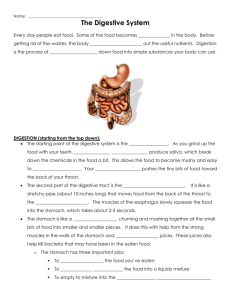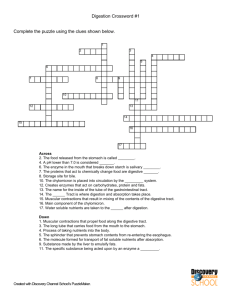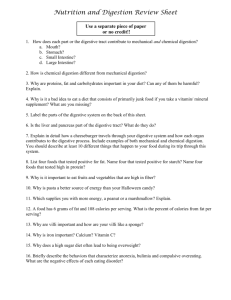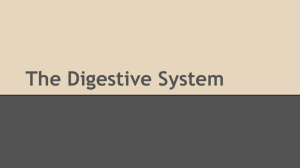Name
advertisement
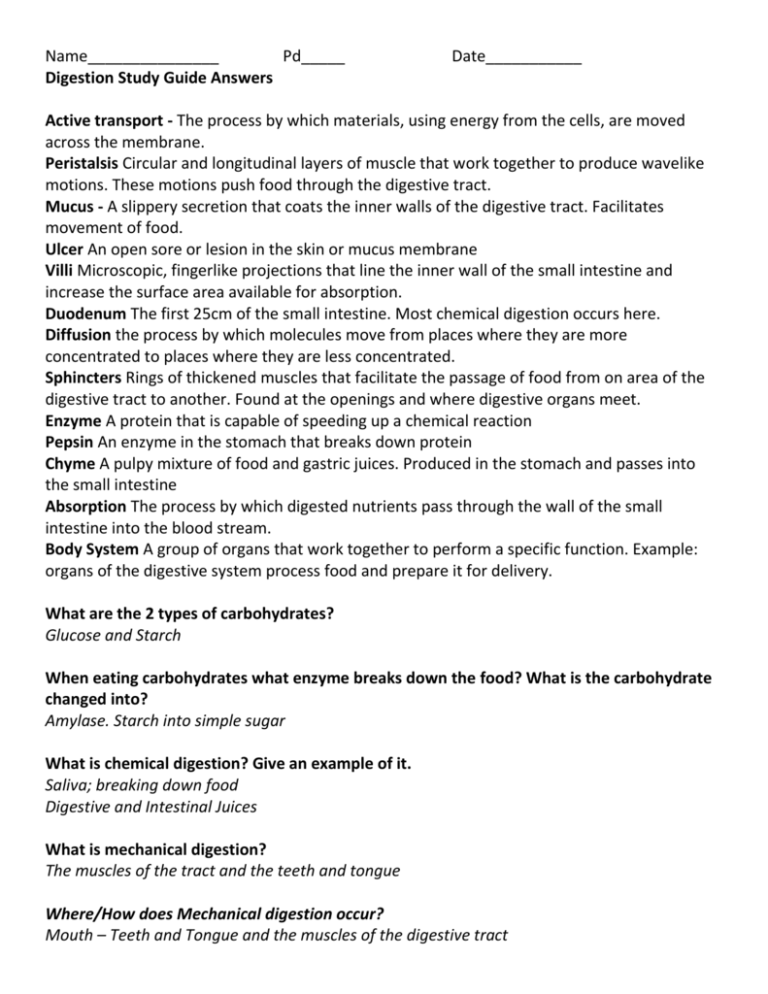
Name_______________ Pd_____ Digestion Study Guide Answers Date___________ Active transport - The process by which materials, using energy from the cells, are moved across the membrane. Peristalsis Circular and longitudinal layers of muscle that work together to produce wavelike motions. These motions push food through the digestive tract. Mucus - A slippery secretion that coats the inner walls of the digestive tract. Facilitates movement of food. Ulcer An open sore or lesion in the skin or mucus membrane Villi Microscopic, fingerlike projections that line the inner wall of the small intestine and increase the surface area available for absorption. Duodenum The first 25cm of the small intestine. Most chemical digestion occurs here. Diffusion the process by which molecules move from places where they are more concentrated to places where they are less concentrated. Sphincters Rings of thickened muscles that facilitate the passage of food from on area of the digestive tract to another. Found at the openings and where digestive organs meet. Enzyme A protein that is capable of speeding up a chemical reaction Pepsin An enzyme in the stomach that breaks down protein Chyme A pulpy mixture of food and gastric juices. Produced in the stomach and passes into the small intestine Absorption The process by which digested nutrients pass through the wall of the small intestine into the blood stream. Body System A group of organs that work together to perform a specific function. Example: organs of the digestive system process food and prepare it for delivery. What are the 2 types of carbohydrates? Glucose and Starch When eating carbohydrates what enzyme breaks down the food? What is the carbohydrate changed into? Amylase. Starch into simple sugar What is chemical digestion? Give an example of it. Saliva; breaking down food Digestive and Intestinal Juices What is mechanical digestion? The muscles of the tract and the teeth and tongue Where/How does Mechanical digestion occur? Mouth – Teeth and Tongue and the muscles of the digestive tract Where/How does chemical digestion occur? Mouth – Amylase in the saliva breaks starch into sugar Stomach – Gastric Juices Small Intestines – Intestinal Juices How does your body absorb nutrients? Diffusion and Active Transport Why do you have a gall bladder? It produces bile to break down fats Food Starts in the mouth where does it continue to travel before ending in the rectum? Esophagus – Stomach – Small Intestine – Large Intestine – Rectum/Anus Describe as much as you possibly can about what happens to food as it travels through the digestive tract. Where does it start, end and what happens at each stop? It begins with mechanical digestion using the teeth and tongue. Salivary Amylase is then secreted to break starched into sugars. Once the bolus of food is small enough it travels down the esophagus into the small intestine were most absorption of nutrients occurs. It then travels to the large intestine and out the rectum, can take upwards of four hours. Because of the colon what is absorbed into the body? Minerals and Water What are the gastric juices? What do they do? Hydrochloric acid and pepsin. They are the digestive enzymes. What characteristics of the small intestines help the absorb nutrients? Wrinkles and folds Describe saliva and what it does to food. Produces by 3 glands in the mouth and it makes food moist Describe each of the following. Why do you need them? Vitamins – Build blood cells, build chemicals to control the nervous system, Minerals – Build bones teeth and blood cells and regulate chemical and electrical signals that control how the body works Protein – Build tissue, repair damage, and make hemoglobin to transport oxygen through your blood Water – Everything is packed with water, brain is ¾ water and bone is 20% water What six nutrients does your body need? Carbohydrates, Proteins, Fats, Vitamins, Minerals, and Water
